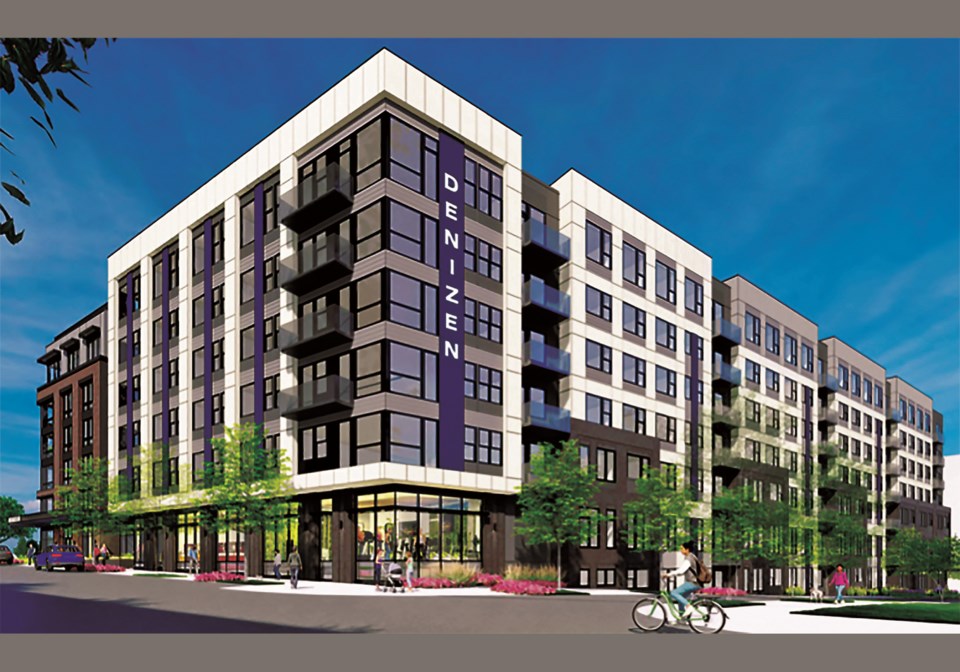A proposed mixed-used development around the West Falls Church Metrorail station has drawn plaudits from “smart-growth” advocates, but neighbors still have doubts about traffic impacts and parking availability.
The Fairfax County Planning Commission on Feb. 8 deferred until March 8 its decision on whether to recommend that the Board of Supervisors approve the proposal.
FCGP-Metro Development LLC is seeking a rezoning to construct 85 townhouses, 810 multi-family dwelling units, 110,000 square feet of office space and 10,000 square feet of retail area. The development would have a floor-area ratio of 0.96.
Located in Dranesville District, the subject development area is known as Sub-unit A-1 of the West Falls Church Transit Station Area and located immediately south of the West Falls Church Metro station.
The five parcels, which total just shy of 24 acres, are zoned almost entirely R-30 residential. The site has two long-term surface-parking lots, a five-story parking garage, a bus loop and a kiss-and-ride lot. the applicant would retain the parking garage for use by Metro riders and keep the existing stormwater-management pond as well.
The applicant would contribute $30 million worth of upgraded infrastructure, $1.3 million to Fairfax County Public Schools, $1.2 million to the county’s Park Authority and about 2.5 acres of parks.
Development would occur in four phases. Infrastructure would come first to ensure continued access to the Metrostation and then be followed by construction of townhouses and a multi-family building with up to 320 units, plus infrastructure and park spaces to serve those structures.
Phases 3 would construct a building with up to 280 multi-family dwellings and two centrally located parks. Phase 4 would construct another multi-family building and an office building.
Most roads within the development would have only a single travel lane, between 10 and 13 feet wide, in each direction. The narrower lanes are aimed at keeping speeds down.
The applicant also is proposing to build wide sidewalks, shared-use paths and on-street bicycle facilities throughout the development would encourage active modes of transportation, county staff said.
In addition, the applicant has proposed several off-site transportation improvements, including a continuation of West Falls Station Boulevard through the Virginia Tech Northern Virginia Center property to the city of Falls Church line. Other upgrades would include signal-timing adjustments, an additional right-turn lane on Grove Avenue and shared-use trail along Haycock Road between West Falls Station Boulevard and Turner Avenue.
The project would have six parks: a sport court, dog park, civic plaza, pocket park, linear park and children’s recreational area. Other amenities would include public art and streetscape elements such as street trees, pedestrian-scale lighting, pergolas, benches and decorative pavements.
The application would meet the county’s 10-year tree-canopy standard by exceeding the tree-preservation goal and supplementing that with native plantings.
The county’s comprehensive plan for the West Falls Church Transit Station Area calls for more affordable and workforce housing than the countywide standard, including 15 percent of for-sale units and 10 percent of rental dwellings. The applicant has proposed to meet those requirements, staff said.
The proposed development resulted from a “spirit of remarkable cooperation” between the applicant and Fairfax County, city of Falls Church, Washington Metropolitan Area Transit Authority (WMATA) and Virginia Tech, said Andrew Painter, the applicant’s attorney.
The joint goals were to attract new investments, increase Metro ridership and build housing, Painter said. The applicant’s project would complement adjacent ones being pursued by Virginia Tech and Falls Church city and result in a 42-acre “integrated, seamless neighborhood” with 3.2 million square feet of office, retail, hotel and residential uses, he said.
“We have tried to make this as by-the-book as you can possibly get,” Painter said. County staff “certainly held our feet to the fire on that account,” he added.
Planning Commission member John Ulfelder (Dranesville District) said he was confident stormwater issues at the site could be worked out.
The applicant is required to provide 1,781 parking spaces, but is asking for a reduction to 1,095. The developer is seeking a 44-percent parking reduction for multi-family buildings, 34 percent for townhouses, 14.3 percent for retail but none for the office uses, Painter said.
“If the board is going to reduce parking anywhere in the county, it makes the most sense to do so in a transit-rich environment at a Metro station, which is not only served by Metrorail but by three different bus lines,” he said.
If supervisors approved the project this year, the applicant likely would break ground in late 2024 or early 2025, Painter said. Complete build-out of the project probably would take eight to 10 years.
Commission member Candice Bennett (At-Large) called it a “beautiful design” and “great plan,” but said the applicant should pay special attention to provision of loading spaces. She also did not favor such a large parking reduction.
The Planning Commission’s new chairman, Phillip Niedzielski-Eichner, said he would have favored more density at the site.
“We do have public investment of substantial magnitude at our Metro stops and it’s incumbent upon us to maximize that investment,” he said.
Aaron Wilkowitz, who lives a quarter-mile from the site, favored the application “100-percent,” saying it would contribute toward affordable housing and improve the area’s aesthetics and amenities.
Cheryl Sim was concerned about traffic and pedestrian safety ,and said recent maintenance-related closures of area Metro stations may lead some residents to conclude they do need vehicles to get around.
Adrienne Whyte, president of the Ellison Heights-Mount Daniel Civic Association, said the three planned developments around the Metro station when combined would “dramatically change the stability” of surrounding neighborhoods, increase traffic on local roads diminish quality of life for those residents.
Whyte also opposed the applicant’s parking reduction plan and said it was unrealistic to assume residents and employs using the site would not drive vehicles.
“I will not use Metro for any reason because I consider it unsafe and unreliable and it doesn’t to the locations I visit regularly in Fairfax and Arlington counties,” Whyte said.



